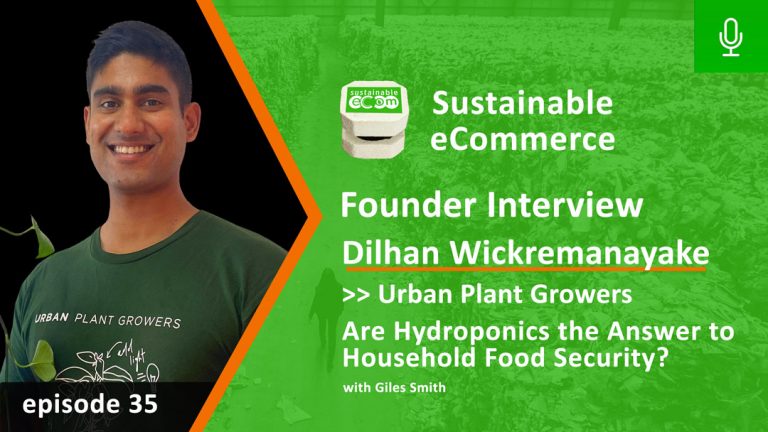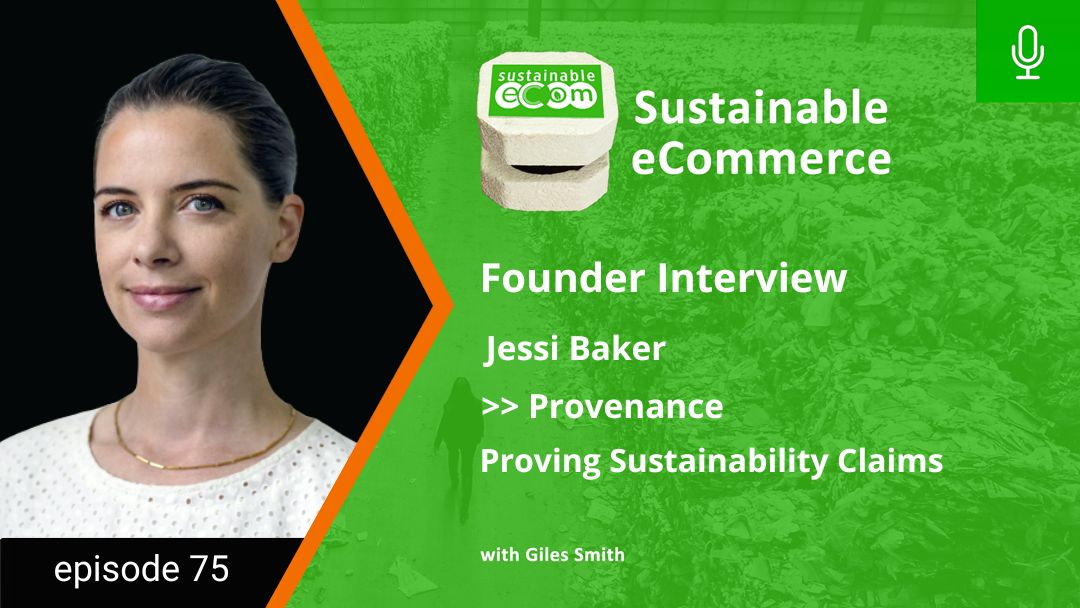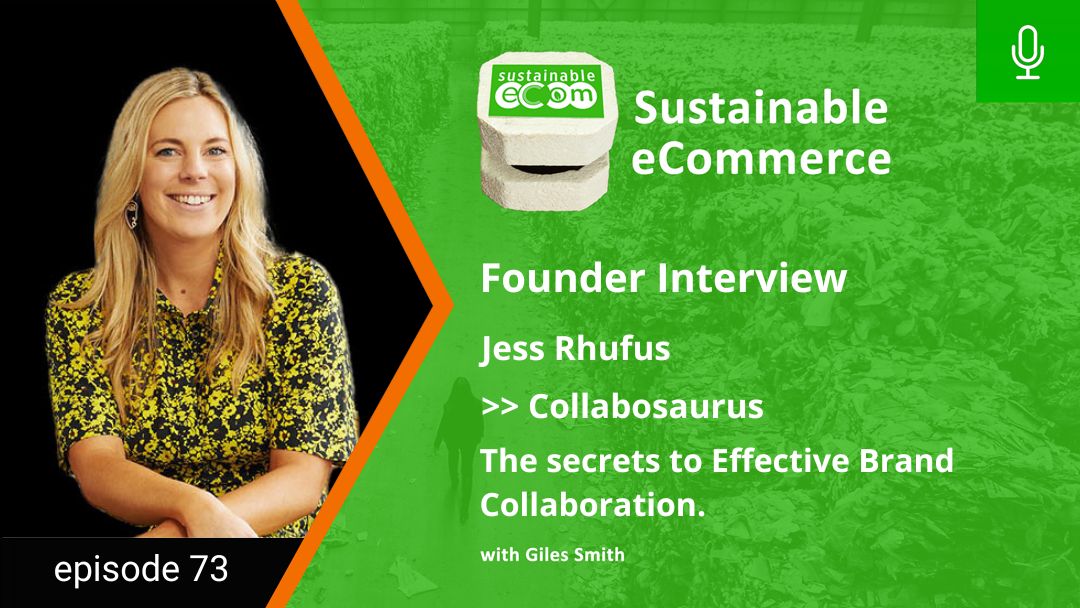Episode 35 - Sustainable Ecommerce Podcast
I do love the little veggie garden we have at home. There’s something super nice about plucking some fresh herbs and greens eating them moments after harvest.
Plus we haven’t been buffeted by lettuce-flation since the floods!
But I’m lucky enough to live on a big plot, millions of Aussies simply don’t have the opportunity to grow fresh herbs and greens, until now!
My guest today is Dilhan Wickremanayake, co-founder of Urban Plant Growers. They are helping Aussies with food security, food waste and reduce the carbon footprint of food miles with their very cool hydroponic indoor plant solutions.
As you’ll hear their solutions for fast, water efficient, and highly predictable food growth are changing lives from the big smoke to about as Outback as you can get.
Santa, if you’re listening, I want one!
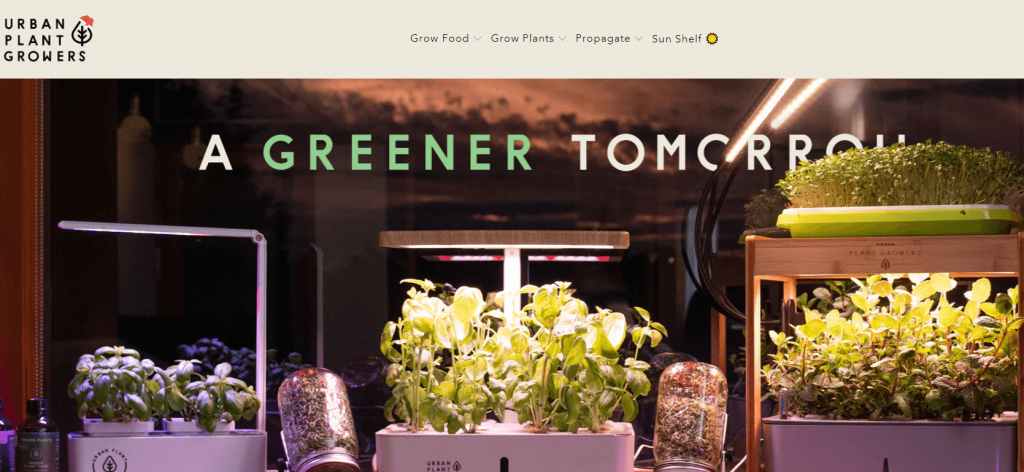
Giles Smith: Dilhan, welcome to the show!
Dilhan Wickremanayaka: Thanks so much for having me!
Giles Smith: How did you guys came to start Urban Plant Growers?
Dilhan Wickremanayaka: The origin story of Urban Plant Growers starts when I met my co-founder, Peter Cole. We were both at Uni studying engineering and we were both very into the environment and sustainability.
Peter had been looking into hydroponics as a way of enabling everyday people who lived in apartment buildings to kind of grow their own food. At the same time, I was very interested in sustainability and I had been working in renewable energy and energy efficiency, but was also starting to see that agriculture played a key role in climate change. I was hoping to build large scale commercial vertical farms, but as soon as I chatted to Peter, I realized that idea makes a lot more sense.
Giles Smith: Amazing. Obviously, the last few years have been interesting in terms of food supply, but I guess the value proposition of using hydroponics is making a lot more sense these days.
Dilhan Wickremanayaka: Yeah, definitely does. These are all things that we saw very early on in the business. Our thesis was that with climate change, increasing urbanization, the increasing global population and the reduction in fresh water availability would all lead to food security issues in the future.
That comes through in things like ridiculously priced lettuce or an overproduction in avocados, but they're only going to get worse. We're hoping that we can give people the equipment they need to grow their own food sustainably in their own home.
Giles Smith: So the three things you guys are focussed on are food waste, food miles, and food security. I think most people can get their head around food waste. I think probably most people can get their head around, food miles. What is food security and why is it a big deal for us?
Dilhan Wickremanayaka: Yeah, so food security is having, consistent, reliable, and affordable access to a healthy, nutritious diet. Australia isn't actually as food secure as you might initially think, especially if you go out into rural areas where it might cost $5 for an apple.
Some rural communities produce food, but sell it all off because it the economic drivers push them to do that rather than use it for themselves. So they end up substituting with sugars, fats and processed food.
Australia in such a dry places, we forget that 80% of Australia is very dry and hard to grow things. It's quite expensive to truck things out across our massive country to, to smaller communities and actually get them fresh food.
Giles Smith: And so what about the cities though?
Dilhan Wickremanayaka: It's still an issue in the cities. The supply chains are suited to meet the requirements of the city. But because of factors like the floods, the war in Ukraine, food is still getting very expensive and in unpredictable supply.
Giles Smith: What is hydroponics and how is that a great solution for home-based growers?
Dilhan Wickremanayaka: So, hydroponics refers to growing plants with water, without a soil substrate. So instead of having a garden where you've got soil and you add water to your plants and they grow, you can have the plant roots hang directly into water.
The soil provides structure for the plant roots to grow in and actually have a solid foundation so the plant can grow upwards. It also has a range of macro and micro nutrients required for plant growth, as well as an aerated medium for the roots to grow.
You can mimic all of that inside. We have a special rock cubes that is two centimeters by two centimeters and then four centimeters tall. It’s like a rock that's been heated up to a really high temperature and then spun around like fairy floss. And the benefit of that is that you get a super porous material that has thousands of tiny air pockets, and it also holds onto water.
The result is that when you put a seed in, you have a 97% chance of germination. So it's a very high success rate. Um, when the plant roots start growing out of that Rockwell cube, they grow into our hydroponic solution, which is basically just water and we provide a bottle of hydroponic nutrients and you mix in five mils per liter of water.
The second part that's commonly associated with hydroponics is LED grow lights that mimic the wavelengths of the sun.
Plants primarily just need small sections of light between 400 and 500 nanometers and 600, 700 nanometers. So to the visible eye that's blue and red.
So I guess to summarize it, hydroponics is kind of a mixture of things, but basically growing plants in water using a hydroponic liquid solution, a medium to hold the plants, and artificial sunlight.
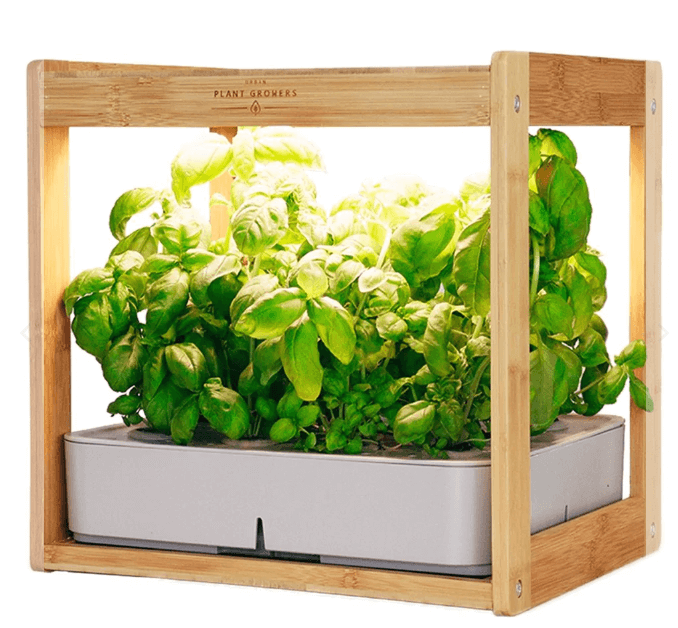
Giles Smith: What was the first product you brought and how did you get that first thing to market?
Dilhan Wickremanayaka: The first product we worked with was about the size of a toaster. You could grow two plants at the same time. It had a one liter water reservoir and an LED grow light.
We found a product that already existed overseas and we just brought it to Australia back in June, 2018. It took is 3 or 4 months to figure it all out, get a website up etc, then it all started to come together by Christmas. That first year in December, we made $10,000 worth of sales, which proved to us that people were interested in the space.
So we decided to expand our range and take it from there. At that point we started building relationships with the whole heap of manufacturers and trying to get things done. Now, we've got 13 major main products that we service, and then we provide all the accessories for it. So we provide seeds, growing mediums, nutrients, testing meters, replacement parts and, and basically everything you'd need to service your product for as long as you use them.
Giles Smith: Who do you perceive to be your primary audience? Who's your core customer?
Dilhan Wickremanayaka: It's a good question and it's sort of changed over time. At the beginning I was doing this business because of sustainability. I was convinced that hydroponics was a better way of growing food. So I was assuming that the reason people were buying our kits were sustainability. After about a year, I started realizing the main driver was convenience. Having things within their own home. Then sort sustainability might be like a second or third factor.
Giles Smith: With the cost of living crisis heating up, are you seeing a switch to return on investment and saving money as a major driver?
Dilhan Wickremanayaka: Yeah, I think people are definitely starting to see ROI as a key feature. We need to make sure that people can get a payback from our product, and we always try to make that payback under a year. There aren't many things in your home that actually save you money, whereas when you’re growing your own greens and you see the price of lettuce increase at the supermarket, people start to think about how much they can grow.
At the start we just thought it would be people living in appartments that buy our products, but over time we realized that our products actually reach a very diverse range of people in a whole heap of regions. We’ve got people from Sydney city to Far North Queensland or Kalgoorlie in WA. Its great for people where its hard for them to get to a supermarket or get fresh food easily.
Giles Smith: It’s interesting that you’ve moved away from your initial demographics-based avatar and are focusing on problems and needs based. The first one is the ability to grow plants reliably and then the second one is having easy, affordable access to healthy food no matter where they live. I really think that's very, very powerful.

Dilhan Wickremanayaka: Yeah, I think it is as well. We want to be the company to help people grow food indoors. Full stop.
Giles Smith: You started out at something like $400K in the first year, and it at least doubled every year since then. What do you put down to that wonderful growth rate? What are you guys doing that's really working for you?
Dilhan Wickremanayaka: It's always hard to put it down to just one thing. It's just focus on the customer and focus on value. So as soon as you start getting products out there you have to figure out ways to make sure they're getting the most out of it, make sure it's actually solving a problem for them.
So we make sure we get the freshest best seeds from seed suppliers in Australia so that when people grow it's going to instantly work and they don't have to worry about going to the supermarket to get stuff themselves.
And then a large part of it is education. Instead of just giving them a kit and telling them to follow the instructions, we try to explain quite thoroughly how hydroponics work.
Growing the business is also about having a bit of vision and figuring out what customers might want even if they don’t know it yet.
Giles Smith: How do you get feedback from your customers?
Dilhan Wickremanayaka: We've got a typical email marketing and a review system, which sends a timed email after a typical growing season, usually around 8 weeks. We’ve also got a strong survey system set up. Every quarter, we'll randomly select a bunch of customers, shoot them a message to grab a bunch of information. Sometimes we identify new pain points from that that we can act on.
Then other than that, we've got a very methodical customer service system. So every single query that comes in gets tagged, and we look for trends in what issues people are running into. I think most of our feedback probably comes from customer service.
Giles Smith: So what tools are you using there?
Dilhan Wickremanayaka: Yeah, so, uh, customer service, we use platform called Reamaze https://apps.shopify.com/reamaze They're basically like Zendesk, but specifically for e-commerce. They've got a lot of very intelligent automation features that they've released including chat bot builder.
For the reviews, we use Stamped.io.
I think as a team we do customers service quite well. We actually have a customer service team, making sure that people have the best possible outcomes. We generally go the extra mile. There will be times where something goes wrong with a product and someone from our team will just drive out, meet them, fix whatever they've got that's going wrong and have a chat to them and kind of figure out why they're interested in growing.
Giles Smith: You've gone to New Zealand, you've gone to the UK. What does that process look like?
Dilhan Wickremanayaka: Scaling out to New Zealand and the UK happened in different ways. New Zealand was quite easy, we use our warehouse in Sydney to send all our stock out. We just have a separate store. New Zealand has very strict biosecurity laws, so some of our seeds & nutrients we can’t send over. So it made sense to have a different online site.
With the UK, it worked out slightly differently. We had a mentor who we sent some stock to initially and she sent orders out for us while we were testing the market. We had to source seed suppliers and nutrient suppliers from there too.
Eventually we found a fulfilment partner over there who holds stock and ships out our orders now.
Giles Smith: What's next over the next 12 to 24 months?
Dilhan Wickremanayaka: I guess the key is doing a lot of product development. We’re working on an aquaponic product, we're working on a large indoor grow shelf style, and we’re we're working on a product for vegetables. That will be a big thing for carbon reduction, for every Kilo of tomatoes there’s 430 grams of carbon emissions before it gets to your home. So we see a big opportunity there in reducing carbon mileage.
I think a big part of our redevelopment will be sustainable design. We are redesigning a lot of our products to fit within this new style and vision for the brand, including looking at different components, maybe making the casing here in Australia from recycled plastic. Plus, we’re always looking to reduce our carbon footprint, especially around the warehouse.
Giles Smith: Can you give us some tips on what you can optimize?
Dilhan Wickremanayaka: I guess it's all the fundamentals, like sensors and dimmers, upgrading to LEDs. Focusing on HVAC is usually where people spend most of their energy. So just using efficient heat pumps and not using the air con when you don't need it.
At the end of the day, last mile distribution is very footprint heavy, so locating your warehouse near your customers is important. Even teaching your staff to recycle properly.
Giles Smith: Where can people get their hands on some of these incredible hydroponics?
Dilhan Wickremanayaka: So all of our products are available on our website. Urbanplantgrowers.com.
Giles Smith: So thanks very much for sharing your time today.
Top Takeouts
Firstly, I think we mostly take an abundance of food for granted. Yet, food security even in the cities of Australia is in much greater peril than perhaps we realised.
The impact of climate change on our food supply has definitely been felt over the past few years, and if you’ve been doing online shopping with the major super markets, I’m sure by now you’ve come to expect all sorts of fresh produce being unpredictably in its availability.Beyond that, with the rising cost of living, and more food inflation sure to come as the global shortage of wheat and fertiliser hits next year, investing in home hydroponics is looking more and more promising.
- In many ways, UPGs product fits into the food technology category, and like any tech the more complicate it is, the more support and education is required to deliver an outstanding brand experience. Dilhan and the team are not skimping in that area, having invested in an AI-chatbot, an on shore dedicated care team, and even making home visits to help. That kind of layered thinking and exemplary service is rare, but nevertheless necessary, and I applaud them for their commitment.
Dilhan example in terms of learning about their avatar is a highly instructive in terms of helping you build out your own customer profiles. They started out with a demographic-based profile, but quickly realised that didn’t fit.
Now their avatars are problem based. Demographics, especially stuff like age, location, gender & occupation are largely meaningless, and it comes down to the problems people have with the predictable and affordable access to food, or predictable ability to grow & propagate plants.
If your avatars are largely focused on demographic data, I encourage to take a fresh look at your own definitions and see if focusing on the customers goals and challenges leads to a more meaningful orientation for your content and marketing.
If you need help with that, we are just about to launch our new online programme which teaches you how to implement the Purpose Marketing Playbook, and there’s a whole module in there on defining your problems based avatar.
I’ll be back again next week with more stories from the world of Sustainable Ecommerce, so until then, keep building your brand for a healthier planet!






